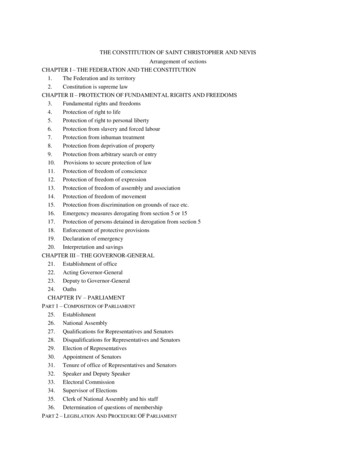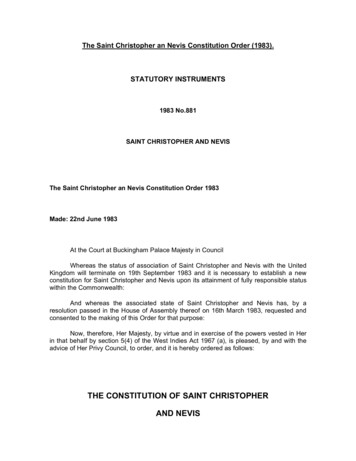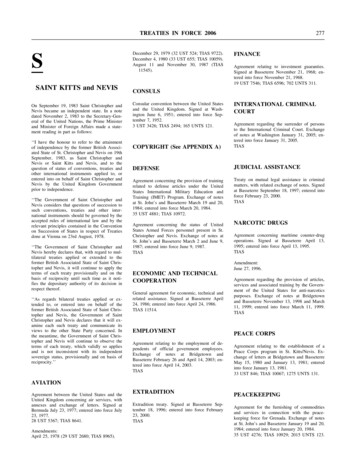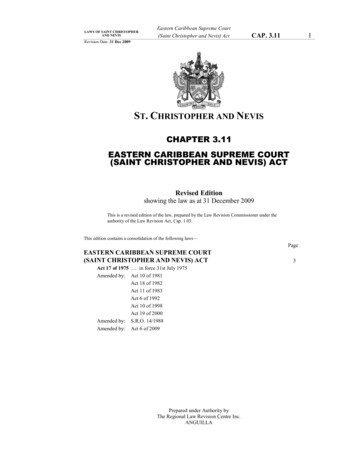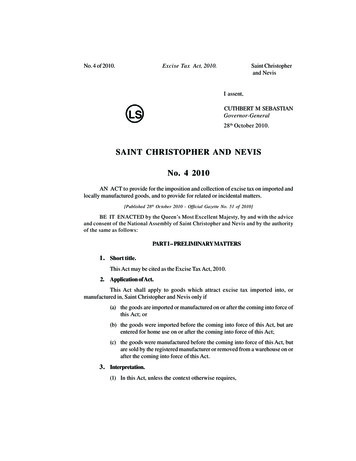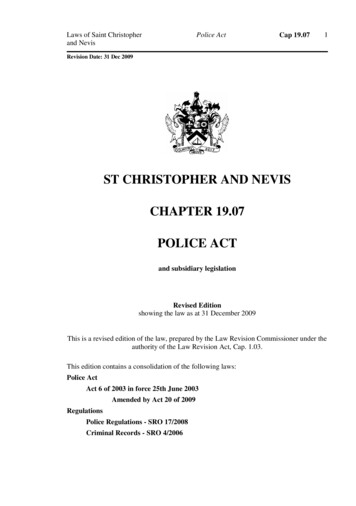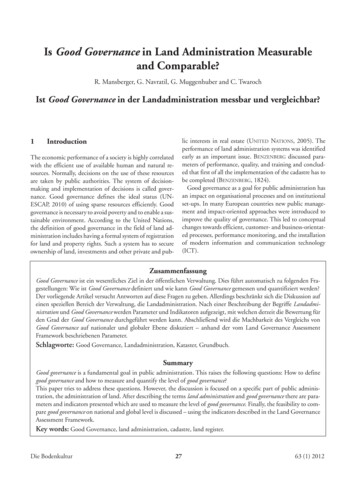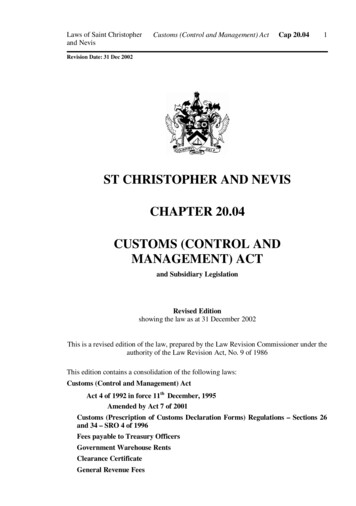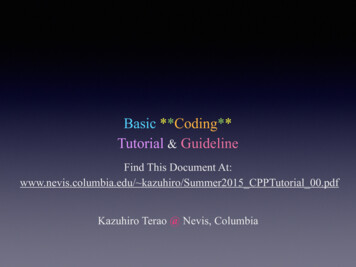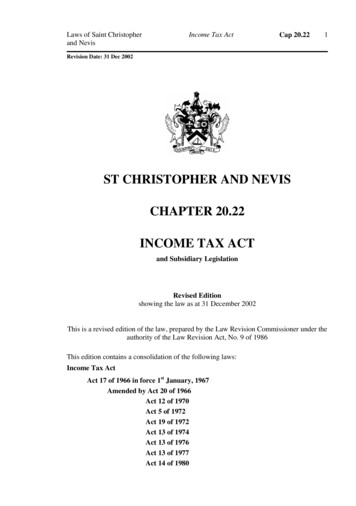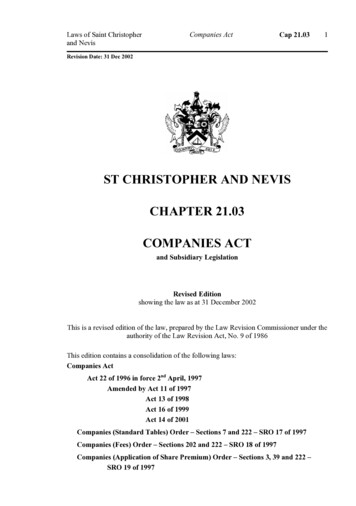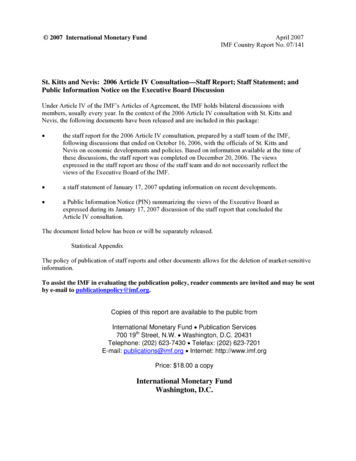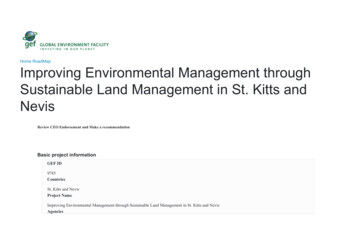
Transcription
Home RoadMapImproving Environmental Management throughSustainable Land Management in St. Kitts andNevisReview CEO Endorsement and Make a recommendationBasic project informationGEF ID9785CountriesSt. Kitts and NevisProject NameImproving Environmental Management through Sustainable Land Management in St. Kitts and NevisAgencies
UNEPDate received by PM5/29/2019Review completed by PM2/19/2020Program ManagerAsha Bobb-SempleFocal AreaMulti Focal AreaProject TypeFSPPIF CEO Endorsement Project Design and Financing1. If there are any changes from that presented in the PIF, have justifications been provided?Secretariat Comment at CEO Endorsement7/2/2019:Yes. However please clarify the following:
- Please explain the need to change the execution agency from a Government Agency to a GEF Implementing Agency.- We note with concern the reduction in the number of hectares to be targeted. Please clarify what is meant by Special Purpose Vehicle?Please also indicate thetentative sites which could be identified for interventions once the project has started.-The allocations by focal are have changed since the PIF stage. An updated OFP endorsement letter will need to be submitted.8/26/2019:Cleared.Response to Secretariat comments7/18/2019- Change of execution agency from a Government Agency to a GEF Implementing Agency: The GOSKN has adopted a collaborative approach with partners tofacilitate execution of the myriad of initiatives on sustainable development in the country. This is due on part to resource constraints, but is also the government’sapproach to strengthening networks for collaboration with regional and international partners. This has been a precedent with several other initiatives implemented byorganizations such as FAO, UNDP, etc. Text clarifying this has been included in section A.6 of the CEO-ER and Section 4 of the ProDoc.- the reduction in the number of hectares to be targeted: At PIF approval the PPG phase was to have more concretely assessed the costs for the SLM andrestorative interventions. The labour and materials costs particularly for a small island state are relatively high and when applied over the initial hectarage at PIF stagewas determined to be prohibitive in consideration of the other project elements that need to be funded. Hence, the available project budget for these activities wasinsufficient to cover the number of hectares initially proposed at PIF approval (650 ha). In light of this, and the need to balance resources to adequately cover the otherproject components, the proposed strategy is to ensure that the practices, methods and tools are extended to farmers, land users, other stakeholders at the broadest levelso that as much in influence from the project is exerted over management of landscapes in the country. This will be done through the agricultural, reforestationactivities, extension services to farmers and other stakeholders in order to enhance and improve the understanding and application of ANR and reforestation conceptsand activities for sustainable management of crops.The text under Components – Outcomes – Outputs in section Output 2.1.1 of the CEO-ER document and section 3 of the ProDoc respectively attempted to capturethis explanation. However further clarification has been provided in the narrative under these sections, specifically under Outcome 2.1 in both CEO-ER and ProDoc.- clarify what is meant by Special Purpose Vehicle: According to SKN debt management strategy Management-Strategy-2013-2015.pdfThe debt-for-land swap covering approximately EC 900 million in secured loans and overdrafts owed to domestic banks has been executed, and is expected toshortly come into effect. Two special purpose vehicles (SPVs) are being established to manage the land sale process and also hold some of the land to be exchanged.
The SPVs will be managed professionally on an arm’s length basis, following best international practice. As the land is transferred to the lender of the SPVs, the debtssecured by relevant land assets will be cancelled in their totality, with no further recourse to the Government. In this way, the debt for land swap will provide thecountry with extraordinary debt relief in a way that preserves and even strengthens the stability of the domestic banking sector. This therefore means that landssubject to debt-for-land swap cannot be considered as intervention sites for the project as per the query on reduction of the number of hectares to be targeted as theimplications of the management of the lands under the SPV became clear after the PIF was approved.- indicate the tentative sites which could be identified for interventions once the project has started: The geographic locations for the interventions have beenfurther clarified; St. Kitts: the steep upland watershed areas adjacent to the Central Forest Reserve and National Park inland from the communities of Fahies, Belmontand Newton Ground in the western part of the island, upland areas adjacent to the communities of Sadlers, Tabernacle, Philips and Cayon along the northern part ofthe island, and in the south in the Wingfield area; Nevis: The New River community and the coastal areas under aggressive erosion in the western part of the island.Note that the Ministry of Sustainable Development and the Agricultural Department maintains that further discussions may result in some further adjustments in siteselection and will be considered at project start-up. The text in both the CEO-ER and ProDoc under the ‘project sites’ section and section 3.3 respectively, have beenupdated to reflect this. Revised maps showing the locations have been added in the CEO-ER document (Figures 3 and 4).- The allocations by focal are have changed since the PIF stage: An updated letter from the OFP has been acquired and attached with the resubmission.2. Is the project structure/ design appropriate to achieve the expected outcomes and outputs?Secretariat Comment at CEO Endorsement7/2/2019:Not fully. Please address the questions below.Table B/Project Description- Output 1.2.2- Please confirm how GSKN will ensure the staff who are awarded scholarships are retained for the benefit of future initiatives-In terms of maintenance. Output 2.1.1- How will the nurseries be maintained (financial and human resources) after the projet has ended and in particular for upscalingpurposes. The same question applies to the enhancements to the existing GIS system under Output 1.2 and the drones mentioned in the project budget and Appendix13.--Output 2.1.2- How is the mangrove restoration being coupled with added protection for the mangroves? We note the importance of replanting, but also consideringthe potential to lose the mangroves elsewhere or in the same location in the future.
-Output 2.2.1- There is no reference to the financing programme metioned in the project description. Is there a target associated with the program, in terms of no.farmers assisted etc. Additional information would be useful on the potential program and partners such as private sector and their role.-We note that this intervention will require the removal of invasive species. What is the long term plan for maintenance and control of the invasive species.-Output 3.2- We note the targeted public education and awareness campaign (Appendix 18). What are the plans to test the effectiveness and impact of theintervention? Other-We would like to see specifically how gender will be considered and mainstreamed in the project interventions. We note the considerations made in the Gender andProject Results Framework sections of the CEO ER as well as the Safeguards section of the Project Document. However please provide additional details in Table Bas well as the project description of the CEO ER and the Project Document on how gender will be incorporated.-As activities related to earth dams and water ponds will not be undertaken, please remove references to these interventions throughout the project document(Stakeholders section, TORs, Procurement Plan etc)-The Safeguards section refers to renewable energy, please clarify.-Please ensure the figures in the Ex-Act tool match the target hectares as described in the project text (CEO ER).8/26/2019:Responses are cleared.The Table B referenced is in the portal version of the CEO Endorsement Request i.e Table B- Project Description Summary.Re the GIS software, we encourage you to also consider open source options as any related costs may be easier to maintain following project completion.Response to Secretariat comments7/18/2019
Output 1.2.2- Please confirm how GSKN will ensure the staff who are awarded scholarships are retained for the benefit of future initiatives: This is detailedin Appendix 17 (item i) of the UNEP ProDoc. The program will support the initial deployment of at least six students, who will be required to provide co-financingthrough the provision of service to the SKN government through bonded agreements of service, thus ensuring that knowledge and expertise acquired benefits thegovernment for a minimum number of years. Bonded agreements are standard practice where public servants receiving support are required to sign commitment toservice commensurate with the value of capacity acquired.Output 2.1.1- How will the nurseries be maintained (financial and human resources) after the project has ended and in particular for upscaling purposes.As stated in the narrative, farmers best-suited to participate based on their history of farming in areas adjacent to critical areas will be at the core of capacity buildingand front-line beneficiaries. To enhance sustainability these farmers will enter into co-management arrangements with the Department of Agriculture in theestablishment and operation of the field nurseries. It is anticipated that these co-management agreements will be result in long-term investment by the farmers andsupported via associated farmer cooperatives. This information has been added to the narrative of Output 2.1.1 in section 3 of both the CEO-ER document and theProDoc.The same question applies to the enhancements to the existing GIS system under Output 1.2 and the drones mentioned in the project budget and Appendix13: Please note enhancement of GIS systems is considered under Output 1.1.3 and not Outcome 1.2. The GOSKN has very limited GIS capacity and there is lack ofa national repository and clearing house on environmental data and other relevant information. There is no standing committee of key government departments todevelop or supervise the development of a National Spatial Data Infrastructure (NSDI) and a National Land Information System (NLIS). The project will support theenhancement of the GIS system by providing trainings, building capacity, practical application of approaches as well as equipment (e.g. GIS software, drones) toimprove data collection and analysis aiming to improve land use planning and policy development. The idea is that after the project ends, the GOSKN will beenhanced and be able to maintain the GIS system from own budget. During the project, a sustainability strategy will be explored in order to generate income from theGIS information services related to building permits, environmental monitoring analysis as environmental audits, among others, that could be paid for companies orinstitutions. The Ministry of Environment or the Ministry of Planning should govern this.This is further clarified with additional narrative under section 3 both the CEO-ER and the ProDoc under Output 1.1.3 specifically.Output 2.1.2- How is the mangrove restoration being coupled with added protection for the mangroves? We note the importance of replanting, but alsoconsidering the potential to lose the mangroves elsewhere or in the same location in the future: Output 2.1.2. Includes the conduct of a Rapid MangroveEcosystem Assessment, which will ensure sustainable actions, and will design a mangrove conservation action plan that will take into consideration potential negativeimpacts elsewhere. In addition, policy makers and resource managers will have access to the mangrove conservation action plan and the information andrecommendations generated, data so that conservation efforts can be better targeted.This is further clarified with additional narrative under section 3 of both the CEO-ER and the ProDoc under Output 2.1.2.Output 2.2.1- There is no reference to the financing programme mentioned in the project description. Is there a target associated with the program, in termsof no. farmers assisted etc. Additional information would be useful on the potential program and partners such as private sector and their role.The financing programme as described refers to the facilitation of the development of a protocol on compliance to CSA/SLM best practices that will be linked toaccess to credit (and markets) so as to incentivize the uptake of good CSA/SLM practices by farmers. The project will contribute to the review of existing credit
facility and access mechanisms, including relevant existing incentive (subsidy support) schemes by government and make recommendations for CSA/SLM practiceadoption within credit access schemes. This will be closely coordinated and directed by the Department of Agriculture with technical guidance and support from IICAand the FAO, based on needs articulated mainly by the agricultural cooperative societies whose members are the target farmers. The development process will bedefined on project inception in which a target on number of farmers associated with a validation/test will be determined. Development of the programme will includeengagement of the private sector in terms of market access, with focus on main retail outlets and hotels to build on corporate service responsibility in encouraging thatproduce supplied is from SLM/CSA-compliant practice.This clarification has been added to the narrative in section 3 of the CEO-ER and ProDoc, under Output 2.2.1.-We note that this intervention will require the removal of invasive species. What is the long term plan for maintenance and control of the invasive species.The project refers to control of invasive vegetation species at the site level where active interventions will take place. This will entail a combination of physicalremoval and other control measures to reduce further proliferation over the time until the desired rehabilitation and planting measures take effect. In the longer-term,as lands are recovered and revert to more SLM/CSA management regimes and active management measures are in place by the farmers, it is expected that invasivespecies will be reduced and kept in a low presence. It should be noted also, as included in the project narrative, that the GEF funded regional project “Alien Species(IAS) in Barbados and the OECS Countries” aimed at managing the risks and costs of invasive alien species on important ecosystems was launched in St. Kitts andNevis in March 2019. This project will focus on prevention, early detection and the establishment of control and management frameworks for IAS that emphasize arisk management approach by prioritizing the highest risk invasion pathways. This project will coordinate closely with the regional IAS project (and the nationalcomponent in St. Kitts) to avoid duplication, understand the lessons learnt and support replication.This clarification has been added to the narrative under “Coordination with ongoing projects” and section 3 (output 2.2.1) of the CEO-ER and sections 2.7 and 3(output 2.2.1) of the ProDoc.-Output 3.2- We note the targeted public education and awareness campaign (Appendix 18). What are the plans to test the effectiveness and impact of theintervention? A local consultant will be hired to evaluate the impact of the public awareness campaign. This is specified in the Procurement Plan, Appendix 9 of theUNEP ProDoc. The methodology will involve the conduct of on-site knowledge-attitude-practice-behavior (KAPB) surveys of stakeholders actively engaged in theproject and wider civil society and other indirect stakeholders on the effectiveness of messaging from the project. Other means such as direct interviews and feedbackfrom face-to-face, written and other inputs will be captured and complied. This has been reflected in the text of both CEO-ER and the ProDoc under section 3 (output3.2.1) respectively.Other-We would like to see specifically how gender will be considered and mainstreamed in the project interventions. We note the considerations made in theGender and Project Results Framework sections of the CEO ER as well as the Safeguards section of the Project Document. However please provideadditional details in Table B as well as the project description of the CEO ER and the Project Document on how gender will be incorporated. Yes, undersection ‘A.4. Gender Equality and Women's Empowerment’ and specifically under subsection ‘Project Activities to promote Gender Equity’ of the CEO-ERdocument, and under the Environmental and social safeguards section of the ProDoc this was extensively elaborated. To reiterate, gender mainstreaming will beincorporated in the implementation of all capacity building processes, as well as promoting planting of nurseries, reforestation activities and mapping of marketpotential. These include for example design and implementation of gender oriented methodology to promote inclusive spaces within the existing governance structureof the local community, in which women particularly have an active presence as well as the challenges they face regarding their participation and decision making, inorder to identify opportunities that will lead to more inclusive processes. It should be noted that the project will take into consideration the recently launched National
Gender Equality policy launched in December 2018 by GSKN. Further, the results framework sets out gender-related targets that will be assessed over projectimplementation. These provide orientation to the project in the gender mainstreaming process.Clarification is requested on which ‘Table B’ is being referred to, if this was the intention.-As activities related to earth dams and water ponds will not be undertaken, please remove references to these interventions throughout the projectdocument (Stakeholders section, TORs, Procurement Plan etc): Noted and these references have been removed and replaced with the term water storage tanks.-The Safeguards section refers to renewable energy, please clarify. This was included in error and has been removed.-Please ensure the figures in the Ex-Act tool match the target hectares as described in the project text (CEO ER). A prior version of the Ex-Act tool wassubmitted. The updated version is now provided.3. Is the financing adequate and does the project demonstrate a cost-effective approach to meet the project objective?Secretariat Comment at CEO Endorsement7/3/2019:Not fully. Please clarify the following.- Please justify the need for GEF financing for a project vehicle-Annex F-1 refers to a National Project Coordinator, however the Budget notes refers to a Regional Project Coordinator. Please clarify.-The budget notes make mention of an M&E specialist, however there is no TOR (Appendix 10) provided or description in the Procurement Section (Appendix 13).Please provide.8/26/2019:As indicated in the Guidelines on the Project and Program Cycle Policy- GEF/C.52/Inf.06/Rev.01, the use of GEF funds to purchase vehicles is strongly discouragedas such costs are normally expected to be borne by co-finance. Any request to use GEF funding to purchase project vehicles must be justified. Following a review ofthe justification provided, we will not be able to support the purchase of a project vehicle. Please adjust the budget accordingly.10/10/2019:
Following further internal review by our policy team, and in keeping with our policies, please see questions below for consideration and response.-We note that several specialists have been categorized as 'project staff' within the budget. If these specialists are not charging 100% of their time to the project, theyshould be included in the Consultants/International Consultants line items as appropriate. If they are, then they will be considered as project staff to be paid by thePMC. Please adjust accordingly.-In relation to the above, for the Sustainable Agriculture Specialist, the project document indicates that this is a staff member who will be a part of the PCU and willcharge 100% of their time to the project. In this case their charges will have to assigned to the PMC (to be shared between GEF financing and co-financing).Otherwise, adjustments to the terms of employment should be considered.-Please reassign all of the project coordinator financing to the PMC, which should be shared between the GEF Financing and the cash co-financing that has beenidentified for the project.12/10/2019:The responses and adjustments have been noted. We also note that the TOR for the Project Coordinator has been adjusted in view of technical responsibilities that willbe carried out. However as written, the TOR is not clear on what specific technical tasks will be undertaken by the project coordinator under each of the components.Please clarify and revise.Additionally, we recommend, utilizing the co-financing available to the PMC category, to assist with covering the Project Coordinator costs. We note that the budgetline for Administrative Staff has cash co-financing of 1.4M and 496,922 in kind.2/6/2020:ClearedResponse to Secretariat comments7/18/2019- Please justify the need for GEF financing for a project vehicle This is substantially a field project, which will require significant coordination and mobilisationof project staff to the project sites and will necessitate engagement with stakeholders in the field. Reliance on the small number of existing vehicles of the departmentof Agriculture will be problematic in terms of ensuring timeliness and responsiveness to the project needs. This was conveyed by the Ministry of SustainableDevelopment and Department of Agriculture during the project development process. This explanatory note has been added in the procurement plan in the ProDoc tomake clear.
-Annex F-1 refers to a National Project Coordinator, however the Budget notes refers to a Regional Project Coordinator. Please clarify. Noted; this has beenchanged to National Project Coordinator.-The budget notes make mention of an M&E specialist, however there is no TOR (Appendix 10) provided or description in the Procurement Section(Appendix 13). Please provide. The TOR for the M&E specialist has now been included in Appendix 10 of the ProDoc. Note however this will not represent anadditional procurement as this role will be carried out by IUCN.9/4/2019 RESPONSEFollowing a review of the justification provided, we will not be able to support the purchase of a project vehicle. Please adjust the budget accordingly:Accepted; the vehicle purchase has been removed from the proposal. Note the changes in the Budget and PRODOC (specifically in Appendix 13, Procurement Plan)have been adjusted accordingly.11/17/2019 RESPONSEWe note that several specialists have been categorized as 'project staff' within the budget. If these specialists are not charging 100% of their time to theproject, they should be included in the Consultants/International Consultants line items as appropriate. If they are, then they will be considered as projectstaff to be paid by the PMC. Please adjust accordingly: The budget has been revised on the basis of the PMC threshold in consideration of the guidance. Thesespecialists have been moved to consultant budget lines.-In relation to the above, for the Sustainable Agriculture Specialist, the project document indicates that this is a staff member who will be a part of the PCUand will charge 100% of their time to the project. In this case their charges will have to assigned to the PMC (to be shared between GEF financing and cofinancing). Otherwise, adjustments to the terms of employment should be considered.: This specialist has been shifted to the consultant line.-Please reassign all of the project coordinator financing to the PMC, which should be shared between the GEF Financing and the cash co-financing that hasbeen identified for the project: The project coordinator will undertake technical responsibilities under the project hence a portion of the salary of the PC has beenretained under the project component budget. The TORs for the PC Appendix 10 has been adjusted to reflect this.12/10/2019 response:The responses and adjustments have been noted. We also note that the TOR for the Project Coordinator has been adjusted in view of technicalresponsibilities that will be carried out. However as written, the TOR is not clear on what specific technical tasks will be undertaken by the projectcoordinator under each of the components. Please clarify and revise. The TORs for the project coordinator have been further defined in respect to the anticipatedtechnical functions, with references to the activities and outputs that the PC will be expected to contribute to. Please refer to Appendix 10.Additionally, we recommend, utilizing the co-financing available to the PMC category, to assist with covering the Project Coordinator costs. We note thatthe budget line for Administrative Staff has cash co-financing of 1.4M and 496,922 in kind. An adjustment has been made to reflect co-finance contribution
in the amount of 47,400 toward the cost of the Project Coordinator. This adjustment is now reflected in both the GEF budget and co-financing budgets. The amountremoved from the PC cost has been allocated to the technical components (budget line for national consultants).It should be further noted that the co-financing contributions from the Ministry of Sustainable Development and the Ministry of Finance (NAO European Union) areassociated with ongoing and anticipated initiatives that, while are directly associated with this project, these resources are however not earmarked to support projectcoordinator costs. The co-financing represents personnel and other costs that are linked to initiatives under these ministries.4. Does the project take into account potential major risks, including the consequences of climate change, and describes sufficient risk response measures? (e.g., measures toenhance climate resilience)Secretariat Comment at CEO Endorsement7/2/2019:Yes8/26/2019:Cleared.Response to Secretariat comments5. Is co-financing confirmed and evidence provided?Secretariat Comment at CEO Endorsement7/2/2019:Yes. However please adjust the Co-financing letter from the Ministry of Finance to include the US equivalent.8/26/2019:
Thank you for this note. We await the updated co-financing letter prior to processing the CEO Endorsement. Please ensure that the figure in the letter aligns with thecorresponding figure in Table C.Response to Secretariat comments7/18/2019However please adjust the Co-financing letter from the Ministry of Finance to include the US equivalent: An adjusted co-financing letter has been requestedfrom the Ministry of Finance via the OFP. This is still being pursued and will be forwarded as soon available. Kindly note that the prevailing Euro to USD exchangerate at the time of receipt of the co-financing letter was:Source: es/historical/table/EUR-USD.htmlThis was used to convert the Eur 4,920,000 to an equivalent of USD 5,629,833 based on on-line currency exchange information at the time of finalization of the cofinancing tables in the project documents. This has been added as a footnote following Table C of the CEO Endorsement Request.9/4/2019 RESPONSE:We await the updated co-financing letter prior to processing the CEO Endorsement. Please ensure that the figure in the letter aligns with the correspondingfigure in Table C.: The updated co-financing letter has been received. Figures updated to reflect USD amount in letter on the following documents: Appendix 2 –Co-financing budget and throughout PRODOC and Endorsement Request.6. Are relevant tracking tools completed?Secretariat Comment at CEO Endorsement N/AResponse to Secretariat comments7. Only for Non-Grant Instrument: Has a reflow calendar been presented?
Secretariat Comment at CEO Endorsement N/AResponse to Secretariat comments8. Is the project coordinated with other related initiatives and national/regional plans in the country or in the region?Secretariat Comment at CEO Endorsement7/2/2019:YesResponse to Secretariat comments9. Does the project include a budgeted M&E Plan that monitors and measures results with indicators and targets?Secretariat Comment at CEO Endorsement7/2/2019:Yes. However please clarify the GEF related costs associated with the preparation of the Inception report, Semi-Annual Reports, Reports of PSC Meetings, PIRs andProject Final report which have been associated with IUCN. Our expectation is that the Project Coordinator (of the PCU ) will undertake these tasks and they arecovered under the costs for this Project Staff.8/26/2019:Cleared.110/10/2019:Following further review by our policy team, please see additional comments below.There are a number of items included in the M&E budget which are ineligible and will need to be reallocated to other line items within the budget. These are:
-Semi-Annual Progress Reports and the PSC Meetings and Advisory Technical Meetings which have been identified as the 'Project Coordinator’s staff timeestimated for these activities’. Please reassign these costs to the PMC category only, which should be shared between GEF financing and the cash co-financingavailable for the project.-The Financial Audit costs will need to be reassigned to the PMC, which should be shared between GEF financing and the cash co-financing available for theproject.-The Publication of Lessons Learnt should be reassign
The text in both the CEO-ER and ProDoc under the 'project sites' section and section 3.3 respectively, have been . practical application of approaches as well as equipment (e.g. GIS software, drones) to improve data collection and analysis aiming to improve land use planning and policy development. The idea is that after the project ends .
